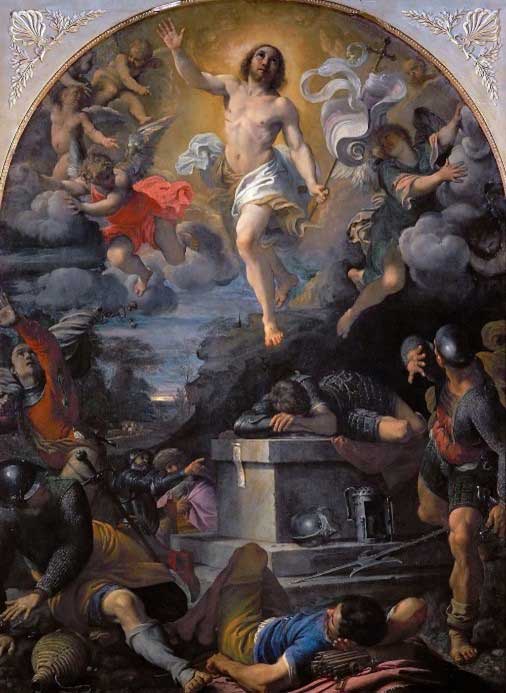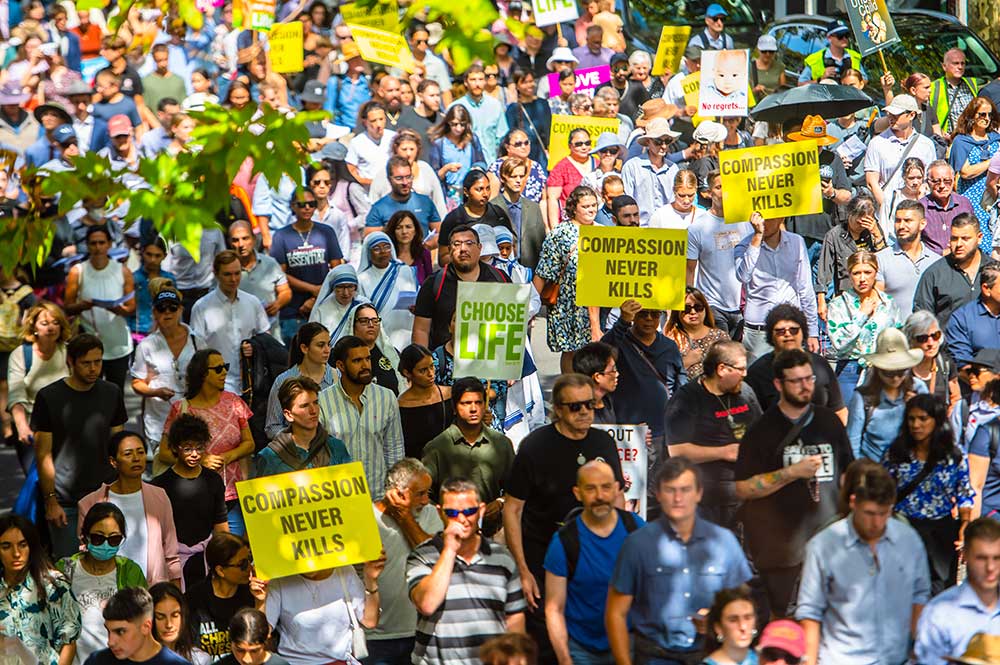Homily for Mass for the 5th Sunday of Lent Year A + Day of the Unborn

St Mary’s Basilica, Sydney, 26 March 2023
‘Jesus wept.’ (Jn 11:35) It’s the shortest and most moving verse of the New Testament. In two powerful words we glimpse the fullness of Jesus’ humanity: that rather than expressing a divine distance, impassability and indifference, Jesus is God come close, so close He could be overwhelmed with compassion for the suffering sisters, so close He could know for Himself the heights of human love and the depths of human grief. Yet this same extraordinary chapter 11 of John offers us another of the Gospel’s shortest lines: “I am the Resurrection and the Life” (Jn 11:25; cf. vv. 26-27)—and the proof that that is so is the raising of Lazarus. Nothing could be better preparation for Good Friday and Easter ahead than to see Christ is weak enough to suffer, die and lie in the grave with us and strong enough to raise us up with Himself in glory.
But is there more to these tears than first meets the (weeping) eye? Well, it’s a gloomy scene. The disciples are terrified of returning to Bethany, so close to Jerusalem, where the plot against Jesus’ life is brewing (Jn 11:8; cf vv. 45-57). Thomas says: if we go there, it’s to die with Lazarus (v. 16). When they arrive, it’s to all the keening typical around a Middle Eastern funeral (e.g. vv. 31,33). The womenfolk are somewhat sullen, annoyed at Jesus. “Why didn’t you come quicker and prevent his death?” Martha and Mary accuse Him, “He’s supposed to be your dear friend.” (vv. 3,21,32) “And don’t you be trying to enter his tomb,” Martha the practical one warns Him, “Laz is now rotting in his grave. Indeed, for a Rabbi like you to get too close to a corpse would render you unclean too. There’s nothing to be done but grieving.” Emotions are running high, rather dark emotions at that. Even the Master is crying.
In the verse immediately before Jesus weeps, we are told in our translation “Jesus said in great distress” (v. 33);[1] other translations have “Jesus was deeply moved” or “Jesus was greatly troubled in spirit”.[2] Our lectionary translation continues: “and with a sigh that came straight from his heart”.[3] But the Greek word here is eta-raxen ἐτάραξεν and it suggests Jesus was troubled, irritated, even indignant, not just sighing-sad.[4] Why was Our Lord agitated too? After all, He knew that Lazarus was soon to be resuscitated and that in due course they would all be resurrected to eternal life. So why the moans and temper?
ooo

One reading of it is that Jesus is enraged by the lack of faith of those around Him. For all the signs He has worked, including raising people from the dead; for all the professions of faith by the two sisters and his other disciples, it’s clear from the generalised howling and the implied rebukes that their faith in the resurrection was weak and in their faith in Jesus weaker still. Christ’s tears, on this reading, are not just tears of grief but also of sheer frustration, like those He will soon shed over Jerusalem (Lk 19:41-44)—a sorrow wrought by seeing them reject Him and His saving mission.
However, there’s another way to think about Jesus’ tears today: that they are tears of anger over death itself. Life is indignant in the face of Death, Goodness appalled by Evil, God dismayed by the actions of the Devil. Aware that death was not God’s original plan, but a result of humanity’s revolt; aware of the suffering and dying of so many innocents ever since Abel and Cain; aware of the deaths of particular people like Lazarus whom He loved; aware that in due course, humanity would kill millions by warfare and murder, starvation and neglect, abortion and euthanasia; aware, too, of His own impending passion and death, Christ is viscerally moved at the devastation wrought by sin and death (cf. Mk 3:5; 10:14).

This indignation helps explain our Easter talk of Christ’s victory (Acts 2:24; 1Cor 15:54-57; Heb 2:14; Rev 1:18), as if He were a warrior, a champion, a rival with someone. “Now judgment is come upon this world,” Jesus says in the very next chapter of John’s Gospel, “now shall the ruler of this world be cast out.” (Jn 12:31). In many sacred images of the Risen Christ, He is carrying a victory flag. At His feet lie cowering soldiers who only days before had executed Him; or “the Prince of this world”, the Devil, lies crushed beneath the rolled-away stone of the tomb. At Easter we will see that Christ is victorious over everything that diminishes us: the ancient enemy and his more modern inventions, our sin and suffering, pride and ambition. Christ triumphs over all that causes our physical, emotional or spiritual death and over Death itself. His indignation at evil, expressed in sighs and miracles but never in violence and recrimination, will be transformed at Easter into divine judgment and infinite mercy.
Like Christ her beloved, the Church is no stranger to confusion, grief, irritation or despair. She’s there to bury our dead and to accompany us, the survivors, in our grief. She’s there to help convert our violent impulses into peacemaking, our indignation into hope. She’s there to build character and community that responds better to life’s irritations. That’s because the Church knows tears, like the two sisters in our Gospel. But it’s also because she knows that the Man of tears, Jesus, is also the Man of joy, who came that we might have life, life to the full (Jn 10:10), came that our joy may be complete (Jn 15:11). He is the Resurrection and the Life, the antidote to every tear.
ooo
In former times the Fifth Sunday of Lent was called Passion Sunday. From today people redoubled their Lenten penances and prayers, and turned their gaze to the suffering Lord. All images were veiled in purple—as all the statues of this cathedral are now veiled—for it was on this day that Christ went into hiding, removed Himself from public gaze, for the fortnight between raising Lazarus and being raised Himself.
Christ is now veiled, but His power and glory could not be completely hidden. Before going into hiding from those who sought to kill Him, He raised up His friend, and thus the Son of Man was seen to be the Son of God. A week later on Palm Sunday, as He made His humble entrance into Jerusalem, the Son of Man was fêted as the new David. Then came His Passion and Death, when amidst the grossest human cruelty He was crowned and titled King of the Jews. And from the Cross the Son of Man was revealed as the Mercy of God, as forgiveness poured from His lips and a promise of Paradise. Through the bruise-purple veil of human vulnerability peep intimations of glory and causes for hope.
ooo
And so we Christians preach a Gospel of Life and Love in the face of the ancient enemies of life and love. We profess and enact a deep reverence for every human being, for Christ joined them in His incarnation, died for them in His passion, and raises them up to life eternal. We join Christ in His irritation and compassion, in His tears about anything that demeans the person or threatens human flourishing, praying and acting for a world in which life and love are everywhere respected.
[1] JB and NJB translations.
[2] ASV, D-R, ESV, KJV, NIV and NRSV translations.
[3] JB and NJB; similarly ASV, D-R and KJV translations.
[4] MSG, NAB, NCB, NLV, TLB and TOL translations.


Introduction to Mass for the 5th Sunday of Lent Year A + Day of the Unborn
St Mary’s Basilica, Sydney, 26 March 2023
Welcome to St Mary’s Basilica in Sydney for the Solemn Mass of the Fifth Sunday of Lent. Yesterday the Church celebrated the Feast of the Annunciation, remembering that joyous moment when the Creator joined His creation, becoming an unborn child in the womb of Mary. As the Sunday closest to the Annunciation, we celebrate today a Day for the Unborn Child, recognising the innate dignity of all human life, especially the tiniest and most defenceless among us: those in the womb. And because it is a Sunday in Lent, we do so with particular awareness of the background of human weakness, violence and sin, all in need of the Redemption that comes at Easter.
Our commitment to advocacy for the protection of all human life is needed now more than ever. In November this year, legislation permitting euthanasia and assisted suicide in NSW will come into effect. These laws threaten the dignity of the dying, the elderly and the infirm. And because this bad law imposes even upon Catholic nursing homes a duty to cooperate with euthanasia, the nuns and lay people who run our aged care facilities face some terrible choices when those laws come into effect. We pray that Prince of Peace guides all of us, our civic leaders and those leading our aged care, in courageously standing up and protecting all human life from conception to natural death, and that even when provoked our friends will demonstrate the peace of God that surpasses all understanding.
I welcome concelebrating with me today- the Auxiliary Bishops of Sydney, Richard Umbers and Danny Meagher and my brother priests.
I salute Mr Paul Hanrahan, Executive Director of Family Life International and other pro-life leaders and friends. Welcome to everyone present or joining us by live-streaming.

